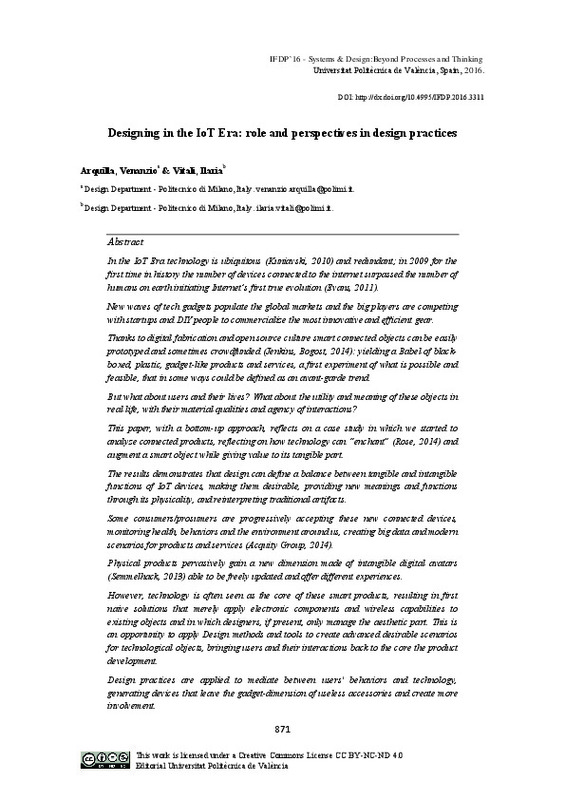JavaScript is disabled for your browser. Some features of this site may not work without it.
Buscar en RiuNet
Listar
Mi cuenta
Estadísticas
Ayuda RiuNet
Admin. UPV
Designing in the IoT Era: role and perspectives in design practices
Mostrar el registro sencillo del ítem
Ficheros en el ítem
| dc.contributor.author | Arquilla, Venanzio
|
es_ES |
| dc.contributor.author | Vitali, Ilaria
|
es_ES |
| dc.date.accessioned | 2017-09-22T07:03:15Z | |
| dc.date.available | 2017-09-22T07:03:15Z | |
| dc.date.issued | 2016-10-27 | |
| dc.identifier.isbn | 9788490484401 | |
| dc.identifier.uri | http://hdl.handle.net/10251/87802 | |
| dc.description.abstract | [EN] In the IoT Era technology is ubiquitous (Kuniavski, 2010) and redundant; in 2009 for the first time in history the number of devices connected to the internet surpassed the number of humans on earth initiating Internet’s first true evolution (Evans, 2011). New waves of tech gadgets populate the global markets and the big players are competing with startups and DIY people to commercialize the most innovative and efficient gear. Thanks to digital fabrication and open source culture smart connected objects can be easily prototyped and sometimes crowdfunded (Jenkins, Bogost, 2014): yielding a Babel of blackboxed, plastic, gadget-like products and services, a first experiment of what is possible and feasible, that in some ways could be defined as an avant-garde trend. But what about users and their lives? What about the utility and meaning of these objects in real life, with their material qualities and agency of interactions? This paper, with a bottom-up approach, reflects on a case study in which we started to analyze connected products, reflecting on how technology can “enchant” (Rose, 2014) and augment a smart object while giving value to its tangible part. The results demonstrates that design can define a balance between tangible and intangible functions of IoT devices, making them desirable, providing new meanings and functions through its physicality, and reinterpreting traditional artifacts. Some consumers/prosumers are progressively accepting these new connected devices, monitoring health, behaviors and the environment around us, creating big data and modern scenarios for products and services (Acquity Group, 2014). Physical products pervasively gain a new dimension made of intangible digital avatars (Semmelhack, 2013) able to be freely updated and offer different experiences. However, technology is often seen as the core of these smart products, resulting in first naive solutions that merely apply electronic components and wireless capabilities to existing objects and in which designers, if present, only manage the aesthetic part. This is an opportunity to apply Design methods and tools to create advanced desirable scenarios for technological objects, bringing users and their interactions back to the core the product development. Design practices are applied to mediate between users' behaviors and technology, generating devices that leave the gadget-dimension of useless accessories and create more involvement. This means changing the actual design perspective adding new skills and attitudes useful to design research, design education and for professional practices. | es_ES |
| dc.format.extent | 12 | es_ES |
| dc.language | Inglés | es_ES |
| dc.publisher | Editorial Universitat Politècnica de València | es_ES |
| dc.relation.ispartof | Systems&design:beyond processes and thinking | es_ES |
| dc.rights | Reconocimiento - No comercial - Sin obra derivada (by-nc-nd) | es_ES |
| dc.subject | Internet of things | es_ES |
| dc.subject | Design | es_ES |
| dc.subject | Research | es_ES |
| dc.subject | Human centered design | es_ES |
| dc.subject | Tangible interaction | es_ES |
| dc.subject | Metadesign | es_ES |
| dc.title | Designing in the IoT Era: role and perspectives in design practices | es_ES |
| dc.type | Capítulo de libro | es_ES |
| dc.type | Comunicación en congreso | es_ES |
| dc.identifier.doi | 10.4995/IFDP.2015.3311 | |
| dc.rights.accessRights | Abierto | es_ES |
| dc.description.bibliographicCitation | Arquilla, V.; Vitali, I. (2016). Designing in the IoT Era: role and perspectives in design practices. En Systems&design:beyond processes and thinking. Editorial Universitat Politècnica de València. 871-882. https://doi.org/10.4995/IFDP.2015.3311 | es_ES |
| dc.description.accrualMethod | OCS | es_ES |
| dc.relation.conferencename | Systems & Design: Beyond Processes and Thinking | es_ES |
| dc.relation.conferencedate | June 22-24,2016 | es_ES |
| dc.relation.conferenceplace | Valencia, Spain | es_ES |
| dc.relation.publisherversion | http://ocs.editorial.upv.es/index.php/IFDP/IFDP/paper/view/3311 | es_ES |
| dc.description.upvformatpinicio | 871 | es_ES |
| dc.description.upvformatpfin | 882 | es_ES |
| dc.type.version | info:eu-repo/semantics/publishedVersion | es_ES |
| dc.relation.pasarela | OCS\3311 | es_ES |








